Opisthobranch parasites
A general page for information on parasites.
See also:
• Symbiosis Page
• Parasites - the copepod Ismaila Page.
• Internal parasites in Aeolidiella alderi & Spurilla neapolitana
• Internal parasites in Spurilla neapolitana.
• Internal parasites in Phestilla melanobrachia.
Rudman, W.B., 2000 (October 24) Opisthobranch parasites. [In] Sea Slug Forum. Australian Museum, Sydney. Available from http://www.seaslugforum.net/find/parasite
Related messages
Re: Splanchnotrophus brevipes from The Netherlands
April 30, 2008
From: Michael Schroedl
Concerning message #20171:
Dear Marco,
during the last years we were doing some taxonomic work on worldwide splanchnotrophids. First on (eastern Pacific and Caribbean) Ismaila, and then on Indo-Pacific genera (see references). We also examined some species of the eastern Atlantic and Mediterranean genera Splanchnotrophus and Lomanoticola. We found that, unfortunately, the old original descriptions of Splanchnotrophus species are not detailed enough to allow proper reidentification (unpublished). We don't know anything about potential morphological variability of species involved either. Our current believe that Splanchnotrophus species can infest different host species may be wrong, since all species of the better explored genera appear to be host-specific.
As many parasites as possible (and of different hosts) should be collected and compared. Best would be fixation with ethanol (90-100%) to also allow molecular work.
-
SCHRÖDL, M. 2002. Heavy infestation by endoparasitic copepod crustaceans (Poecilostomatoida: Splanchnotrophidae) in Chilean opisthobranch gastropods, with aspects of splanchnotrophid evolution. Organisms, Diversity & Evolution 2: 19-26.
-
HAUMAYR, U. & M. SCHRÖDL. 2003. Revision of the endoparasitic copepod genus Ismaila Bergh, 1867, with description of eight new species (Copepoda, Poecilostomatoida, Splanchnotrophidae). Spixiana 26: 1-33.
-
SALMEN, A., WILSON, N.G. & M. SCHRÖDL. In press. Scanning electron microscopical description and biology of three new endoparasitic Ceratosomicola species from tropical Indo-Pacific nudibranch hosts (Crustacea, Copepoda, Poecilostomatoida). Spixiana.
-
SALMEN, A., KALIGIS, F., MAMANGKEY, G.F. & M. SCHRÖDL. In review. A new tropical Indo-Pacific Arthurius species from a sacoglossan opisthobranch host (Crustacea, Copepoda, Poecilostomatoida, Splanchnotrophidae). Spixiana.
Best,
Michael
schroedl@zi.biologie.uni-muenchen.de
Schroedl, M., 2008 (Apr 30) Re: Splanchnotrophus brevipes from The Netherlands. [Message in] Sea Slug Forum. Australian Museum, Sydney. Available from http://www.seaslugforum.net/find/21546Doridicola agilis, another copepod associate
August 22, 2007
From: Marco Faasse
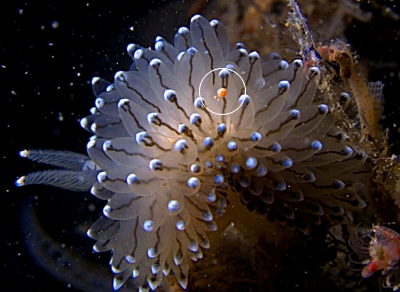
Doridicola agilis is a copepod associated with several species of nudibranchs in the Atlantic Ocean. The exact nature of the association, commensal or otherwise, seems not to be known. There are some reports of this copepod on damaged slugs. However, this concerns only a small minority of the observations. The copepod may be whitish, brownish or orange. The latter colour variety is often the most easy to spot and is beautiful when observed in detail. The specimen on the photos is associated with Janolus cristatus.
Locality: Goesse Sas, Oosterschelde, appr. 10 m, The Netherlands, North Sea, NE Atlantic, 11 August 2001, Boulder slope with bryozoans. Length: appr. 1 mm. Photographer: Marco Faasse.
Marco Faasse
mafaasse@hetnet.nl
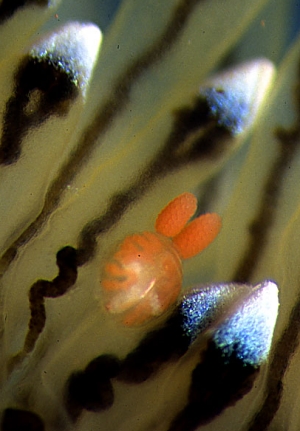
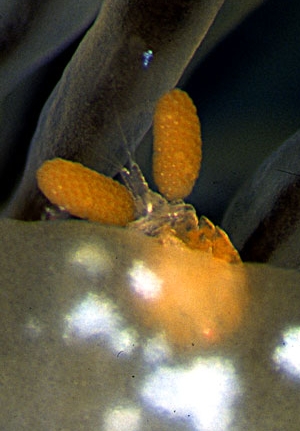
Dear Marco,
Thanks for these wonderful shots. Many tropical opisthobranchs have similar copepod associates. It would be interesting to know just how species specific the associations are.
Best wishes,
Bill Rudman
Re: Splanchnotrophus brevipes from The Netherlands
August 17, 2007
From: Marco Faasse
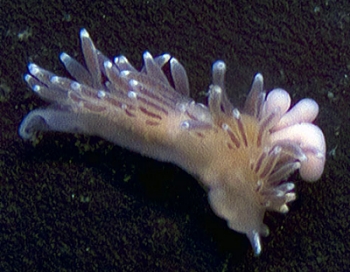
Concerning message #20171:
Dear Bill,
In reply to your comment on my message about Splanchnotrophus:
Those purple egg sacs from the Mediterranean on the Sea Slug Forum you mentioned are very interesting. When searching the internet for Splanchnotrophus images I only found white egg sacs from Spain.
I identified this Splanchnotrophus with Gotto's (1993) book Commensal and parasitic copepods associated with marine invertebrates (and whales) [Synopsis of the British Fauna no. 46]. This book covers the Northeast Atlantic south to southern Brittany, well south of The Netherlands. Gotto (1993) mentions only two Splanchnotrophus species, S. brevipes and S. gracilis. The specimens I have in my collection definitely don't belong to S. gracilis. However, I can't rule out the possibility that they belong to a species unrecorded from our area or even an undescribed species. That precisely was one of the main reasons to post this message on the Sea Slug Forum. I have to say that the specimens found in Cuthona concinna [see photo] were smaller, which may be induced be the smaller size of this host in comparison with Aeolidiella glauca, and that their egg sacs were white. Specimens in both host species were found in April 2007, while Splanchnotrophus has never been recorded from The Netherlands before. To resolve this matter specimens with rose-coloured and purple egg masses would have to be studied more in detail.
Kind regards,
Marco Faasse
mafaasse@hetnet.nl
Faasse, M., 2007 (Aug 17) Re: Splanchnotrophus brevipes from The Netherlands. [Message in] Sea Slug Forum. Australian Museum, Sydney. Available from http://www.seaslugforum.net/find/20492Dear Marco,
Thanks for clarifying how you identified the copepods. I haven't been that good at keeping the list on the parasite page up to date but if you do a search for copepod on the Forum you will find a few more records, including Cratena peregrina and more Spurilla neapolitana from the Mediterranean.
Best wishes,
Bill Rudman
Splanchnotrophus brevipes from The Netherlands
August 15, 2007
From: Marco Faasse

The endoparasitic copepod Splanchnotrophus brevipes lives in seaslugs, with the sausage-shaped egg sacs of the females protruding from the body of the slug. We found this copepod in The Netherlands, where it has never been recorded before. The host slug in this report, Aeolidiella glauca, is an unrecorded host, as far as I know. Later this year S. brevipes was recorded from The Netherlands in another new host, Cuthona concinna [as Trinchesia concinna]. In literature the colour of the eggs is described as white or yellowish. Those observed by us were rose-coloured. Elsewhere on this website I found the similar copepod Ismaila.
Locality: Koepeltje, Grevelingen, 6m, The Netherlands, NorthSea, NE Atlantic, 07 April 2007, muddy slope. Length: appr. 5 mm. Photographer: Marco Faasse.
-
Faasse, M. A. & Lighart, M. 2007. Een parasitair roeipootkreeftje in een naaktslak in de Grevelingen: Splanchnotrophus brevipes Hancock & Norman, 1863. - Het Zeepaard 67(3): 82-84.
Marco Faasse
mafaasse@hetnet.nl
Faasse, M.A., 2007 (Aug 15) Splanchnotrophus brevipes from The Netherlands. [Message in] Sea Slug Forum. Australian Museum, Sydney. Available from http://www.seaslugforum.net/find/20171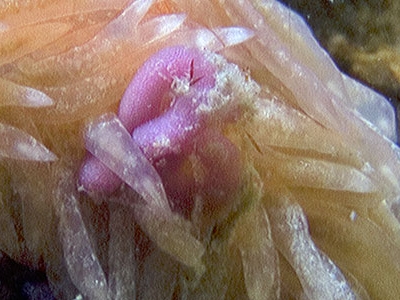
Dear Marco,
If you look on the Parasites page there is at present only a short list, but one of those includes a record of Aeolidiella alderi with the same purple egg masses. If Splanchnotrophus brevipes hasn't been recorded to have purple egg masses how do you know this one is that species? Did you extract the copepod for a look? Is it possible it is another species?
Best wishes,
Bill Rudman
Parasite in Peltodoris nobilis
August 2, 2007
From: Bruce Wight
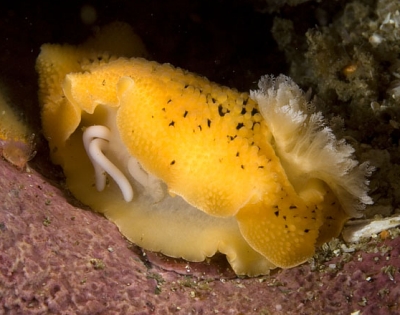
Found this Peltodoris nobilis with what looks like white worms growing from the underside causing it to be contorted as shown. Do you think these are parasites?
Locality: San Miguel Island, 40-60 feet, California, USA, Pacific, 16 July 2007, On reef structure. Length: 1-2 inches. Photographer: Bruce Wight.
Bruce Wight
bruce.c.wight@boeing.com
Wight, B.C., 2007 (Aug 2) Parasite in Peltodoris nobilis. [Message in] Sea Slug Forum. Australian Museum, Sydney. Available from http://www.seaslugforum.net/find/20320
Hi Bruce,
Absolutely. What you are observing here are the egg masses of parasitic copepods whose bodies are buried in the body cavity of the dorid. Looks like there are two individual copepods each with paired egg sacs.
Thanks for sharing,
Dave Behrens
Copepod parasite on Risbecia tryoni
August 12, 2001
From: Erwin Köhler

Dear Bill,
Here is another one from the Philippines by
Peter Schmutz peterschmutz@cs.com. Other data were not recorded.
What is the blue thing behind the gills of the Risbecia tryoni?
Erwin
Erwin@medslugs.de
Köhler, E., 2001 (Aug 12) Copepod parasite on Risbecia tryoni. [Message in] Sea Slug Forum. Australian Museum, Sydney. Available from http://www.seaslugforum.net/find/4959Dear Erwin,
These are the egg sacs of a parasitic copepod which lives attached to the body inside the gill pocket. There are a pair of these sausage sacs attached to the posterior end of the females
Best wishes,
Bill Rudman.
Parasites on Dirona albolineata
October 25, 2000
From: Ellen Hansen
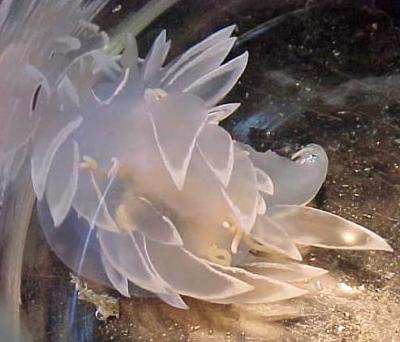
Hi!
I'm doing some research on Dirona albolineata and have come across some interesting parasites (which I'm told are copepods). These parasites somehow make their way into the host and lay egg capsules that are seen streaming off the host. I've had a number of infected hosts die, and would like any information possible: their name, how they infect the host and how it is infectious. It breaks my heart to see them infected and there seems to be no research on it.
These animals where collected in Bamfield, British Columbia, Canada by scuba in both wave sheltered and exposed areas. Any input would be great.
Thanks,
Ellen
ellenkhansen@hotmail.com
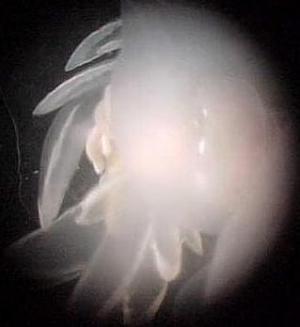

Dear Ellen,
I hope someone can help us out with some information on your parasites. It would be interesting to know of anyone working on these parasites. There are of course a whole range of copepods living in association with opisthobranchs ranging from those that just seem to scurry around on their bodies (see Symbiosis Page) to more serious pests such as Ismaila.
I would be interested to know what sort of research you are doing with Dirona.
Best wishes,
Bill Rudman.
